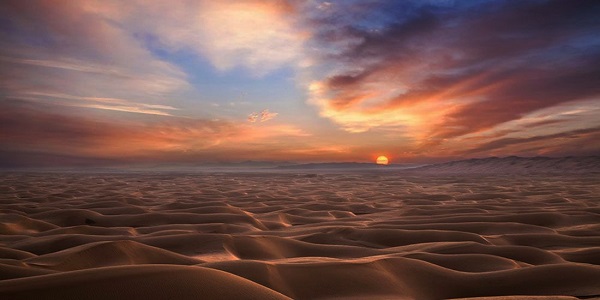visitpars When contemplating Iran, numerous travelers envision expansive deserts and golden sand dunes. Although Iran boasts more than just deserts, featuring snow-capped mountains and lush green forests, it is undeniable that it serves as an exceptional destination for sand dune expeditions. The desert, indeed, spans one-third of the country, encompassing two major deserts and several smaller ones. Are you prepared to embark on an exploration of these remarkable landscapes? In this article, we will acquaint you with the ten finest deserts in Iran, promising an unforgettable journey.
Over half of Iran’s terrain is comprised of dry and semi-arid deserts, distributed across 18 distinct regions. These deserts exhibit diverse characteristics, ranging from landscapes dominated by expansive sand dunes, exemplified by the Maranjab region, to those defined by colossal rock formations, reminiscent of the iconic Monument Valley in the USA, as seen in the beautiful Kaluts.
Iran features two primary deserts. The first and largest is Dasht-e Kavir, extending across the central part of the country and encompassing the majority of renowned desert destinations. The second is Dasht-e Lut, situated in the southeast, recognized as one of the hottest places on Earth, with certain areas devoid of all forms of life, including bacteria.
Recognized as the Great Salt Desert, Dasht-e Kavir stands as Iran’s largest desert, spanning an area of 77,600 square kilometers. Situated on the central plateau of Iran, in the southeast region of the Alborz mountains, Dasht-e Kavir is renowned for its salt flats, sand dunes, and salt marshes. Various wildlife, including wild sheep, camels, and gazelle, inhabit this desert.
This desert experiences significant temperature fluctuations. In summer, daytime temperatures can soar to 60 degrees Celsius, only to drop to 30-25 degrees at night. Similarly, winters in the desert can be quite chilly, with daytime temperatures reaching 17 degrees and plummeting to -7 degrees at night.
The desert boasts numerous captivating attractions such as Kavir National Park, Sefidab and Eyn-o Rashid caravanserai, Hoz Ghilooghe and Hoz Soltan, Sirjan Salt Swamp, and Ghaleh Sefi-Ab. However, the most frequented is the Salt Lake (Daryache Namak), covering an expansive surface of 1800 square kilometers.
Dasht-e Lut stands as the second primary desert in Iran and is arguably the most renowned. Situated in the southeast region of the country, spanning across the provinces of Kerman, South Khorassan, and Sistan Baluchistan, it was designated as a UNESCO World Heritage Site in 2016. The Lut Desert, indeed, is a natural marvel that harbors evidence of human habitation dating back to the 3rd and 4th millennia BC. It is also celebrated for its distinctive rock formations known as yardlangs, contributing to the creation of extraordinary landscapes.
However, this desert, ranking as the 25th largest in the world with an area of 51,800 square kilometers, is notably inhospitable. It holds the record for some of the highest surface temperatures ever recorded on Earth, soaring to 70.7 degrees Celsius.
The Shahdad Desert is situated in the core of Dasht-e Lut, approximately 100 kilometers from Kerman. It is a popular choice for those seeking to witness the impressive rock formations of the Lut Desert known as the Kaluts. These Kaluts, formed around 20,000 years ago through the effects of wind and water erosion, contribute to the creation of a stunning landscape that is often regarded as one of the most beautiful deserts in the world.
Situated near the historic city of Kashan, in proximity to the town of Aran o Bigdol, the Maranjab Desert stands out as one of the most sought-after desert destinations in Iran. The vast majority of this desert is characterized by expansive sand dunes, creating an enchanting setting for activities such as camel riding, off-road adventures, and sandboarding. Maranjab Desert is also home to diverse vegetation and wildlife, including foxes, sand cats, lizards, eagles, and more.

As a part of the Dasht-e Kavir, one of the notable attractions in Maranjab Desert is the aforementioned Salt Lake. Serving as a site for salt extraction, the lake is open to visitors, although it is advisable to explore it with a professional guide due to the surrounding swampy lands. Other points of interest in Maranjab Desert include the Maranjab Caravanserai, dating back to the 17th century. This desert was an integral part of the historical Silk Road, and the caravanserai served as a secure resting place for merchant caravans, doubling as a fortress with a garrison of over 500 soldiers stationed there.
6. Rig-e Zarin
Rig-e Zarin, alternatively known as Mughistan, is a sand dunes desert situated to the north of Yazd, and it is a component of Dasht-e Lut. Encompassing an expanse of approximately 27,000 square kilometers, this desert features towering sand dunes that can ascend to heights of up to 150 meters, along with limited vegetation and wildlife. Despite the challenging living conditions, a small number of nomadic tribes call this area home. At the heart of the desert stands a black mountain soaring to an elevation of 2050 meters, earning the desert its moniker, the “Black Desert.”
Situated within the confines of the recently designated UNESCO Geopark of Tabas in western Iran, the Halvan Desert is renowned for its stunning date palm tree orchards. At the center of this desert lies the village of Halvan, characterized by distinctive and eye-catching architecture, along with a captivating castle adorned with 13 towers. The region also features a salt marshland and the Salt Khor Lake.
